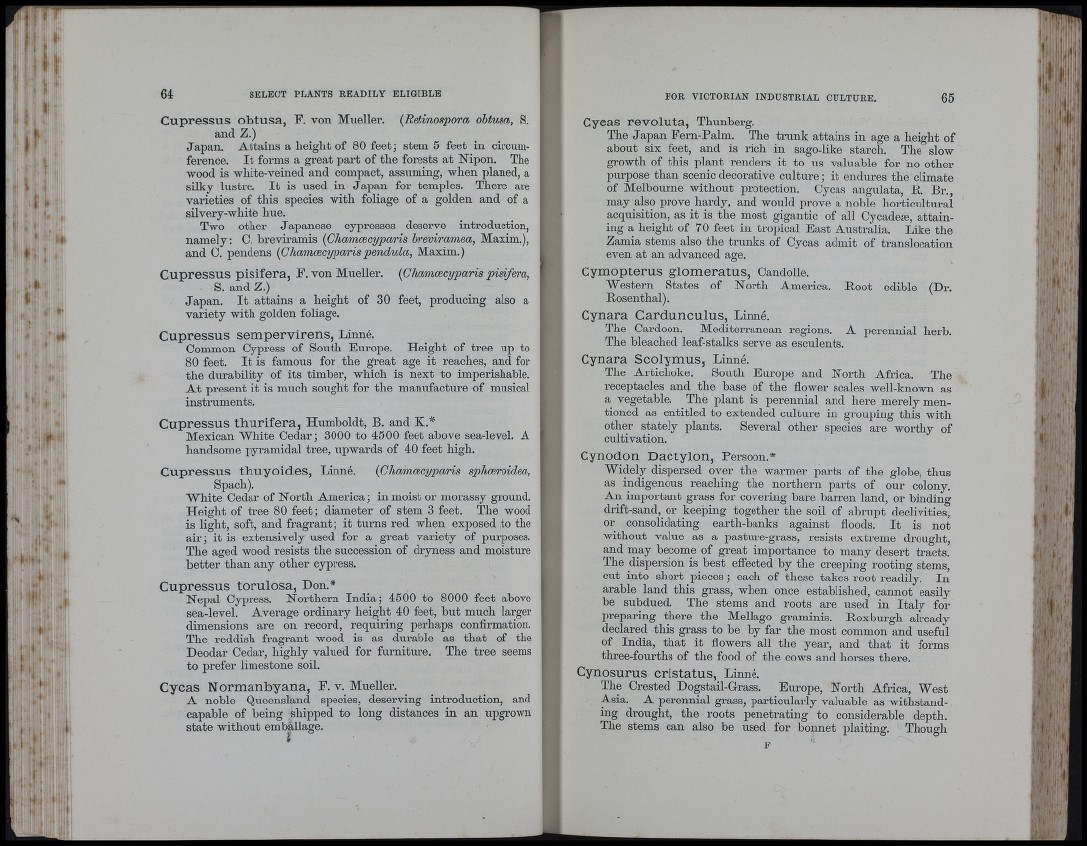
iIl I: ï
I »
• t
.14
♦.
.■ Il
r
’Hi
i"' f
r >•
t ' I .
64 SELECT PLANTS READILY ELIGIBLE
Cupressus obtusa, F, von Mueller. (Eetinospora obtusa, S.
and Z.)
Japan. Attains a height of 80 feet; stem 5 feet in circumference.
I t forms a gi-eat part of the forests at Nipon. The
wood is white-veined and compact, assuming, when planed, a
silky lustre. I t is used in Japan for temples. There are
varieties of this species with foliage of a golden and of a
silvery-white hue.
Two other Japanese cypresses deserve introduction,
namely; C. breviramis {Chamcecyparis breviramea, Maxim.),
and C. pendens {Chamæcyparis péndula, Maxim.)
Cupressus pisifera, F. von Mueller. {Chamoecyparis pisifera,
S. and Z.)
Japan. I t attains a height of 30 feet, producing also a
variety with golden foliage.
Cupressus sempervirens, Linné.
Common Cypress of South Europe. Height of tree up to
80 feet. I t is famous for the great age it reaches, and for
the durability of its timber, which is next to imperishable.
A t present it is much sought for the manufacture of musical
instruments.
Cupressus tburifera, Humboldt, B. and K.*
Mexican White Cedar; 3000 to 4500 feet above sea-level. A
handsome pyramidal tree, upwards of 40 feet bigb.
Cupressus tbuyoides, Linné. {Chamoecyparis sphoeroidea,.
Spacb).
White Cedar of North America; in moist or morassy ground.
Height of tree 80 feet; diameter of stem 3 feet. The wood
is light, soft, and fragrant; it turns red when exposed to the
air; it is extensively used for a great variety of purposes.
The aged wood resists the succession of dryness and moisture
better than any other cypress.
Cupressus torulosa, Hon.*
Nepal Cypress. Northern India; 4500 to 8000 feet above
sea-level. Average ordinary height 40 feet, but much larger
dimensions are on record, requiring perhaps confirmation.
The reddish fragrant wood is as durable as that of the
Deodar Cedar, highly valued for furniture. The tree seems
to prefer limestone soil.
Cycas Normanbyana, E. v. Mueller.
A noble Queensland species, deserving introduction, and
capable of being shipped to long distances in an upgrown
state without emballage.
■
FOR VICTORIAN INDUSTRIAL CULTURE. 65
Cycas revoluta, Thunberg.
The Japan Fern-Palm. The trunk attains in age a height of
about six feet, and is rich in sago-like starch. The slow
growth of this plant renders it to us valuable for no other
purpose than scenic decorative culture; it endures the climate
of Melbourne without protection. Cycas angulata, E. Br.,
may also prove hardy, and would prove a noble horticultural
acquisition, as it is the most gigantic of all Cycadese, attaining
a height of 70 feet in tropical East Australia. Like tbe
Zamia stems also the trunks of Cycas admit of translocation
even at an advanced age.
Cymopterus glomeratus, Candolle.
Western States of North America. Root edible (Dr.
Rosenthal).
Cynara Cardunculus, Linné.
The Cardoon. Mediterranean regions. A perennial herb.
The bleached leaf-stalks serve as esculents.
Cynara Scolymus, Linné.
The Artichoke. South Europe and North Africa. The
receptacles and the base of the flower scales well-known as
a vegetable. The plant is perennial and here merely mentioned
as entitled to extended culture in grouping this with
other stately plants. Several other species are worthy of
cultivation.
Cynodon Dactylon, Persoon.*
Widely dispersed over the warmer parts of the globe, thus
as indigenous reaching the northern parts of onr colony.
An important grass for covering bare barren land, or binding
drift-sand, or keeping together the soil of abrupt declivities,
or consolidating eartli-banks against floods. I t is not
without value as a pasture-grass, resists extreme drought,
and may become of great importance to many desert tracts.
The dispersion is best eflTected by the creeping rooting stems,
cut into short pieces ; each of these takes root readily. In
arable land this grass, when once established, cannot easily
he subdued. The stems and roots are used in Italy for
preparing there the Mellago graminis. Roxburgh already
declared this grass to be by far the most common and useful
of India, that it flowers all the year, and that it forms
three-fourths of the food of the cows and horses there.
Cynosurus cristatus, Linné.
The Crested Dogstail-Grass. Europe, North Africa, West
Asia. A perennial grass, particularly valuable as withstanding
drought, the roots penetrating to considerable depth.
The stems can also be used for bonnet plaiting. Though
(
i ' h I '
l;| ' r Mi
It
V.’
Ir !
f, t
id
f'" ^
t i